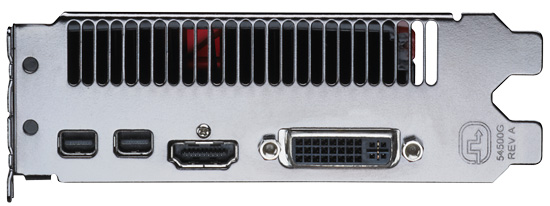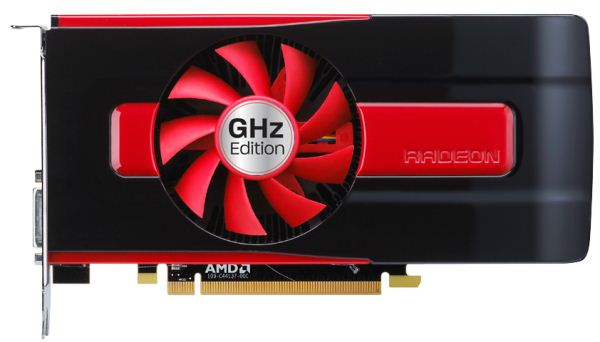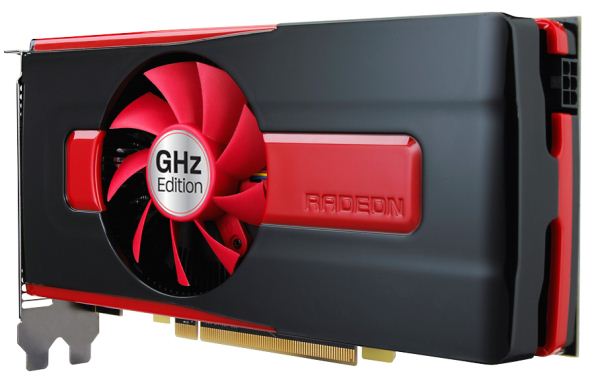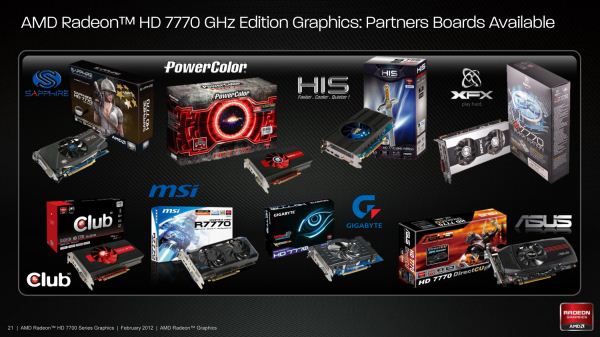AMD Radeon HD 7750 & Radeon HD 7770 GHz Edition Review: Evading The Price/Performance Curve
by Ryan Smith & Ganesh T S on February 15, 2012 12:01 AM EST- Posted in
- GPUs
- AMD
- HTPC
- GCN
- Radeon HD 7000
Meet the Radeon HD 7770 GHz Edition
The second card launching today is the Radeon HD 7770 GHz Edition. Compared to the 7750 it’s based on a fully enabled Cape Verde GPU and features a higher core clock of 1GHz, versus 800MHz on the 7750.
Starting as always with the cooler, for the reference 7770 AMD has gone with something that is best described as half of a blower. The shroud is completely enclosed on the sides, but due to the position of the fan the card exhausts hot air out of both the front and the rear of the card, which is something that’s common for dual-GPU cards such as the 6990 but atypical for a midrange video card. Heat transfer is provided by a basic black aluminum heatsink, while the fan is embedded in the middle of the heatsink.
As for the card itself, it’s effectively an extended version of the 7750. Like the 7750 the card is equipped with 4 256MB 5GHz Hynix GDDR5 RAM chips, along with some additional VRM circuitry to handle the higher 100W power limit for this board. External power is provided by a single 6pin PCIe power socket, while at the top of the card there is a single CrossFire connector. This is actually down from 2 connectors on the 5700 series, which comes as no great surprise as virtually no one ever used tri-CF with the 5700 series in the first place. Overall the card is 8.25” long with no notable shroud overhang, making it the same length as the 5770’s PCB.
Meanwhile for display connectivity AMD is using the same configuration as we’ve seen on the 7900 series: 1 DL-DVI port, 1 HDMI port, and 2 miniDP ports. Unlike the 7900 series AMD’s not requiring their partners to include any adaptors, so buyers with 2 DVI monitors will almost always be on their own. The presence of 2 miniDP ports means that the 7770 has quite a bit of flexibility in driving various displays, however as with the 7900 series if you want to drive more than 4 displays you will need a MST hub, the release of which is still some time off.

As for partner cards, as with the 7750 all of AMD’s partners are doing their own thing. No one will be using AMD’s reference cooler, though PowerColor in particular will be using a cooler similar to it. Everyone else will be using their own double-wide coolers, most of which will be open air as we typically see in this market segment. Like the 7900 series AMD is relying on the 7770 having some degree of overclockability, so there will be a number of factory overclocked cards taking advantage of this.
Finally, I wanted to quickly touch on the naming of the 7770. The official name of the 7770 is the Radeon HD 7770 GHz Edition; with the last bit being AMD’s latest marketing push. Starting with the 7770, AMD is going to be branding every card with a reference clock at or above 1GHz as a “GHz Edition” card to capitalize on the fact that they’ve hit 1GHz. Thus in spite of what the name implies there won’t be a 7770 non-GHz Edition card, as it’s a tagline rather than a true suffix necessary to differentiate cards.
With that said, while hitting 1GHz on a GPU is a notable accomplishment for AMD and should not be ignored, it’s not going to be particularly important in the grand scheme of things. The embarrassingly parallel nature of rendering means that GPU performance isn’t nearly as tied to clockspeeds as CPU performance is, as you can always lay down more functional units to improve performance. Clockspeeds do need to go up over time due to the limited parallelization of the command processor, but otherwise GPU performance has never been heavily dependent on clockspeeds.



















155 Comments
View All Comments
ArizonaSteve - Wednesday, February 15, 2012 - link
Time for the DOJ to start looking into the price fixing that's going on here.A5 - Wednesday, February 15, 2012 - link
Price fixing is explicit, purposeful collusion between 2+ manufacturers to set prices at an unnaturally high level. For an example, see the memory market in the early 2000s.That is not what is happening here.
mattgmann - Wednesday, February 15, 2012 - link
Both of these companies settled price fixing lawsuits in 2008 under similar circumstances. They've cheated before; don't be surprised if they're cheating again.mckirkus - Wednesday, February 15, 2012 - link
If Coke and Pepsi both start pricing cans of soda at $50 each, doesn't mean people will buy them. The 7770 is a $50 can of soda.CeriseCogburn - Wednesday, March 21, 2012 - link
Yeah sure is price fixing when the always victorious gtx460 is $110 bucks and beats the 7770 every time and there's a large stock available...Or the other, triple fan GTX580 at the egg for $359, and the other reduced way down from $500.
AMD is scalping we customers even now and has been since before this review.
chizow - Wednesday, February 15, 2012 - link
There's an easy solution to price fixing: Don't buy at their asking price, or buy the faster, last-gen for cheaper.Its not like GPUs go bad like produce or get consumed like oil. Just keep using whatever you have in your rig now, because chances are its just as fast at a cheaper price than what AMD is asking for these "new" next-gen parts.
Iketh - Thursday, February 16, 2012 - link
meh I'm not worried about it just yet, it's too early... I bet it's because of poor yields, which would make the pricing legitimate... remember it's a new arch on a new nodeif the situation is the same in a month or 2, i'll be among those complaining
akbo - Wednesday, February 15, 2012 - link
I guess AMD is gonna let go of the old 6850 quick, 'cause no one is gonna buy it with this prices. Perf/watt very good tho, although mem bandwith very dissapointing. DDR4 is not coming soon enough, let alone GDDR6. 128 bits are simply not enough and 256 bits is adding more power/complexity. Can't wait for the day when GDDR6 comes and hopefully doubles bandwith for lower power/efficient clock speed. Oh, and gpu companies, when that day comes, don't be stingy like you always are and end up giving us 64 bits instead.silverblue - Wednesday, February 15, 2012 - link
Bring back TBDR and you won't need stupidly wide memory buses. ;)Roland00Address - Wednesday, February 15, 2012 - link
This is figuring out the price per performance, how many dollars you have to spend to get each FPS. Using Anandtech's Crysis: Warhead: 1680x1050 Gamer Quality Everything, Enthusiast Shaders+4xAA (Lower is better since you get a better bang for your buck.) Prices are from Newegg, using the cheapest card out there, no MIR are factored in, price includes shipping. Notes the 7750 and 7770 are not on newegg yet, so I am using the MSRP with no shipping to figure out the FPS per dollar. The GTX460 is using an older anandtech test since it is no longer using the more recent benchFPS Per Dollar/Video Card/FPS/Price/Shipping/Total
$3.81 Radeon 5750 28.1 99.99 6.98 106.97
$3.23 Radeon 5770 32.5 104.99 0.00 104.99
$3.23 Radeon 6850 45.7 139.99 7.56 147.55
3.01 Radeon 6870 53.1 159.99 0.00 159.99
3.46 Radeon 7750 31.8 109.99 0.00 109.99
4.35 Radeon 7770 36.8 159.99 0.00 159.99
3.88 Geforce GTX550 TI 32.7 119.99 6.98 126.97
3.56 Geforce GTX460 1GB 41.4 139.99 7.56 147.55
3.65 Geforce GTX560 48.5 169.99 6.98 176.97
As you can see, the Radeon 7750 is actually a very good card for its price. It beats the old Radeon 5770 series, and all the Geforce only losing to the Radeon 6800 series in the terms of value. Don't forget though the Radeon 7750 can be single slot, doesn't need a 6 pin, and generates less noise and heat.
The 7770 on the other hand is the most expensive card in the terms of value. Notice that Geforce cards have a higher dollar per fps (they have less value), for the Radeon card to succeed it only has to compete with Geforce since Radeon still makes money if you buy one of the other Radeon cards. If the 7770 was priced at 131.01 it would have identical value as the gtx460 1gb, and 142.78 if the card was priced against the value of the GTX550 TI.
I wouldn't be surprised that the Radeon 7770 will drop to the 139.99 or 149.99 price range once all the older 5700 series and 6800 series leave the channel. I do not think we are going to see much cheaper 7750s though since it is a recycled part and its price per performance is very good already. OEMs are going to be eating up the 7750s like candy.